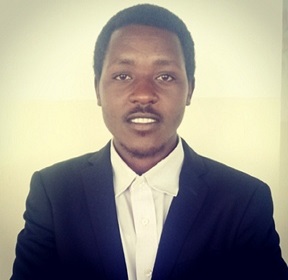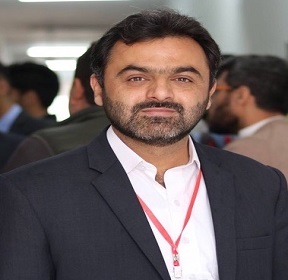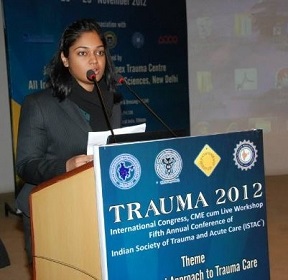Speakers
Shruti Dabi
IndiaTitle: Comparative evaluation of role of Oro-t mouthwash and Smf mouthwash as adjunct to scaling (subgingival irrigation): A randomized clinico-comparative study”
Abstract:
Introduction: Treatment of periodontal disease is routinely based on mechanical debridement of the tooth surface and appropriate and meticulous maintenance of oral hygiene. However, comprehensive mechanical debridement of sites with deep periodontal pockets is difficult to accomplish, therefore systemic or local administration of antibiotics are preferred. But there are various disadvantages with systemic therapy like hypersensitivity reaction, organ toxicity and bacterial resistance. So, to attained the correct required GCF concentration at the target site, led to the use of local drug-delivery system. Ayurveda system of medicine has its root in Indian subcontinent which is being globalized and practices as alternative medicine in the Western world. It is typically based on complex herbal compounds, minerals, and metal substances. Further SMF mouthwash has been used for treating OSMF patient because of its contents which enhanced its properties by improving healing capacity of the tissue. So, in this present study we have planned to evaluate & compare healing potential of both the mouthwashes which is better.
Aim:Comparative Evaluation of Subgingival irrigation Role Of ORO-T Mouthwash and SMF Mouthwash as adjunct to scaling. A clinical comparative study.
Objective
- To evaluate effect of subgingival irrigation ORO-T mouthwash as an adjunct to scaling & root planning (SRP).
- To evaluate effect of subgingival irrigation SMF mouthwash as an adjunct to scaling & root planning (SRP).
- To compare & evaluate effect of subgingival irrigation ORO-T mouthwash & SMF mouthwash as an adjunct to scaling & root planning (SRP).
Materials: Piezoelectric scalers, Oro-t mouthwash, SMF mouthwash,5 ml syringe with blunt cannula. TYPE OF STUDY- A Randomized Clinico-Comparative Split Mouth Study. SAMPLE SIZE- Split mouth study in 30 patients with 120 experimental sites with inclusion criteria involving like Systemically healthy patients, Periodontal pocket depths ranging from ≥5 mm to ≤ 7mm, Requiring Non- surgical periodontal treatment and exclusion criteria involving like patients taking antibiotics for past 6 months, Smokers /Gatka or any form of smokeless tobacco users, Periodontal therapy within past 6 months, Bony defect requiring surgical regenerative treatment and Mobility. Clinical parameters Plaque Index, Gingival Index, Bleeding Index, probing depth, Clinical attachment level were recorded at baseline, at day 14 & day 21 & were evaluated for both Oro -t mouthwash &SMF mouthwash group after giving subgingivally as a local drug delivery as an adjunct to scaling & root planing.
Result: Statistically significant reduction was seen for all the parameters in both the groups when compared with baseline parameters but there was no statistically significant difference between Oro-t mouthwash & SMF mouthwash.
Conclusion: Although there was no statistically significant difference between Oro-t mouthwash & SMF mouthwash in all the parameter’s reduction yet SMF mouthwash can be used as a local drug delivery in replacement of antibiotics (tetracycline fibers) because of its superior properties when compared with turmeric mouthwash. Further researches need to be done.
Keywords-Oral Submucous fibrosis, Clinical attachment level, Oro-T mouthwash, Local drug delivery.
Biography:
Shruti Dabi. have completed my master in dental surgery in the year Aug, 2021 from Rajasthan University of health science, Jaipur (Raj.). Presently She is practicing her field of specialty in her private clinic held in Ajmer (Raj.) India with her dad’s named as Vikram Singh Dabi. She had published 2 original research in international PubMed journals & 1 book in international journal, others are under process. Presently She is working with 4 different journals, as an Editor in 2 international journals [1 dental (PubMed journal) & 1medical (Scopus journal)] & as a Reviewer in 2 international dental journals (Scopus, publons).
Title: Nutraceutical Supplements for Diabetes and Its Complications
Abstract:
Diabetes mellitus is linked with cardiovascular diseases and kidney and liver failures. Although the proper treatment of diabetes includes insulin injection continuously to maintain blood glucose, but nowadays, the researchers following some adjunct natural therapy for diabetes. Bioactive components of herbs and camel milk as nutraceutical supplements can be effective on diabetes and cardiovascular and liver failures. Ginger can directly increase glucose uptake that may be beneficial for type 1 and type 2 diabetes. Using cinnamon in type 2 diabetics for 40 days decreased the blood glucose and lipids of diabetic patients. It is proved that Fenugreek seeds lower blood glucose in diabetes patients by insulinotropic effects of alkaloids. Dietary supplementation of 10 g Fenugreek/day in diabetes cases decreased insulin resistance. Nettle increase insulin sensitivity in muscle and fat cells, thereby increasing glucose uptake into cells and subsequently lower blood sugar. Colocynth was administered three times a day in type 2 diabetes patients, and reduced fasting blood sugar and lipids and glycosylated hemoglobin, increased insulin secretion from pancreatic cells. However, silymarin reduces insulin secretion without causing high blood sugar, and this effect can be helpful in treatment of hyperinsulinemia in type 2 diabetes. Phenolic compounds in Moringa may be to some extent responsible for the anti-diabetic and antioxidant properties. Camel milk contains insulin like proteins, which can be absorbed from the intestine and may be an effective alternative for insulin to treat type 1 and 2 and gestational diabetes. Camel milk may prepare about 60% of the insulin in diabetic patients and reduce blood sugar and required insulin dose. Obviously, camel milk is effective on insulin receptor function, signaling and glucose transport in the insulin-sensitive tissues, and insulin secretion. Herbs and camel milk improve the diabetes complications such as obesity, inflammation, wounds and oxidative stress damages. The anti-oxidative activity of herbs and camel milk whey proteins enhance the proliferation of immune cells and accelerates the wound healing process during diabetes and improve liver failures and lipid profiles in diabetes patients. Due to the side and temporary effects of chemical drugs, the use of bioactive components of herbs and camel milk as nutraceutical supplements along with chemical drugs is recommended for diabetics. But more scientific studies are needed to confirm the effectiveness of these supplements on diabetes cases.
Biography:
Taherah Mohammadabadi finished her PhD in Iran and Australia and has been as a researcher at University of Queensland, Australia; she has attended and presented her works in different conferences in some countries. She is working as academic member, researcher and teacher since 11 years ago in Faculty of Animal Science and Food Technology, Agricultural Sciences and Natural Resources University, Iran. She has been as supervisor for 10 PhD students and more than 30 Msc students. She has over 200 published publications, conferences presentations, and scientific projects; Also, some books on phytochemicals and microbes, bioactive components in the livestock milk; milk lactoferrin and health, anti-diabetes properties of camel milk. She is member of the editorial board and reviewer of some international and national journals.
Jimmy Nkaiwuatei
KenyaTitle: The use of genetic interference mechanisms in treatment of human genetic disorders
Abstract:
Gene interference can be defined as the alteration of the activity of specific genes by altering the regulatory sequences. Gene therapy aims at treating genetic diseases through insertion and expression of specific exogenous genetic materials by transfer of nucleic acids either in vivo or in vitro (through modified cells). This results to expression of a normal product thus correcting the abnormal cellular function. Gene therapy involves two approaches which include germ-line and somatic line gene therapy. In germ-line gene therapy, the germ cells are integrated by exogenous functional genes which can be transferred into the offspring’s while in somatic line gene therapy, the genes are introduced into the patients’ somatic cells and the effects are only experienced on that particular individual. Both methods leads to reduction in the coding mRNA levels. RNA interference not only inhibits transcription, but also induces an RNA degradation process. Gene silencing is enhanced by presence of double stranded RNA (dsRNA) molecules and is initiated by the dicer enzyme, where the dsRNA are cleaved by the protein into small interfering RNA (siRNA) strands which can prime the mRNA of the coding genes to form a duplex (siRNA + mRNA). The duplex activates the RNA-induced silencing complex (RISC) which upon activation degrades the duplex with the critical coding sequences. This is very essential in gene silencing. This gene degradation mechanism thus blocks the process of translation thus inhibiting expression of abnormal proteins responsible for the genetic diseases.
Biography:
Jimmy Nkaiwuatei holds a Bachelor of Science in Biochemistry and Molecular Biology from Jomo Kenyatta University of Agriculture and Technology (JKUAT), Kenya. He is the founding Partner, Find Your Voice Science club and currently the head of Drug Research, Discovery and Innovations Program at Students against Superbugs Africa. He is also a member of Young African Leaders Initiative (YALI).
Najeeb Ullah Khan
PakistanTitle: Significant association of BRCA1, BRCA2 and TP53 gene polymorphisms with breast cancer risk in Khyber Pakhtunkhwa, Pakistan
Abstract:
Background: Molecular characterization of breast cancer heterogeneity facilitates the understanding of disease etiology and progression. More specifically, mutations in known and tumor suppressor genes such as BRCA1, BRCA2 and TP53, result in the alteration of a genomic landscape within sporadic and familial breast cancers. Single nucleotide polymorphisms (SNPs) are described as a mutation with a particular prevalence in certain ethinic population that in turn result in the altered prevalence of disease, the tumor suppressor genes responsible for maintaining the genomic stability. Certain SNPs in BRCA1, BRCA2 and TP53 are known to correlate with elevated risk of breast cancer development worldwide, however there is no such study categorizing the risk of breast cancer development in the Khyber Pakhtunkhwa population in Pakistan.
Objectives: We investigated known associative SNPs on the following risk alleles, BRCA1 (rs1799950), BRCA2 (rs144848) and TP53 (rs1042522) to determine the prevalence of these genetic elements within the Pakhtunkhwa population, and to further stratify the risk of breast cancer risk development conferred by such polymorphisms in the same population.
Methods: To determine the prevalence of known breast cancer associated SNPs, a total of 220 DNA samples were collected via venipuncture procedure. Out of 220, 140 of the samples were obtained from breast cancer patients and 80 were considered age and gender matched healthy controls. Genomic DNA was extracted from the peripheral blood cells and genotyping was performed utilizing a T-ARMS PCR technique. The frequencies of the polymorphisms were checked using SPSS version 16.
Results: Our results indicated that risk alleles of all three selected SNPs showed statistically significant association with breast cancer presence, p<0.05 (BRCA1, C- p=0.001); (BRCA2, C- p=0.000) and (TP53, C- p=0.000). Similarly, all the genotypes carrying risk allele were also significantly associated with the breast cancer risk with p<0.05 (BRCA1, TC- p=0.037, CC- p=0.005); (BRCA2, AC- p=0.000, CC- p=0.000) and (TP53, GC- p=0.000, CC- p=0.000).
Conclusion: The risk allele and risk allele containing genotypes showed statistically significant association with breast cancer risk in our region. More investigation will be required to disseminate the results with large data sets and using whole genome sequencing.
Aparajita Kumar
IndiaTitle: SUCCESSFUL THROMBOLYSIS BY LOW DOSE SLOW INTRAVENOUS ALTEPLASE INFUSION IN CRITICALLY ILL PATIENTS WITH STUCK PROSTHETIC MITRAL VALVE:A CASE STUDY
Abstract:
Prosthetic valve thrombosis(PVT) contributes to significant post valve replacement mortality and morbidity.Treatment guidelines are controversial,ranging from surgical intervention to thrombolysis.We report a case study of two challenging patients who presented in our hospital,known Rheumatic Heart Disease,Post Mitral Valve Replacement,with Acute Left ventricular failure in NYHA class IV and PVT,of which one had coagulopathy with grossly deranged INR.Both patients were put on intermittent non invasive ventilator and inotropic supports,and successfully thrombolysed with low dose slow intravenous Alteplase infusion given every 6 hours in discrete doses with monitoring of PT/INR and mitral valve gradients,resulting in remarkable clinical improvement .Their successful treatment shows that thrombolysis can be considered as an effective treatment modality in high risk surgery patients with stuck prosthetic mitral valve.
INTRODUCTION
Rheumatic heart disease is a commonly encountered cause of valvular heart disease in developing countries like India.PVT is rare,but one of most dreaded complications of prosthetic heart valves,and may have disastrous clinical implications,sometimes life threatening.The incidence of PVT is 0.1- 6 % per patient year in left sided valves,and upto 20% of tricuspid valves.Mitral valve thrombosis is,on an average,5 times more common than that of prosthetic aortic valves.PVT has been classified into two subtypes,obstructive PVT(OPVT),and non obstructive PVT(NOPVT).There have been conflicting treatment modalities despite significant research, with thrombolysis,thrombectomy and prosthetic valve replacement being the available treatment options.There has been no uniform consensus for management of prosthetic valve thrombosis due to lack of randomised controlled trials comparing fibrinolytic and surgical therapy in PVT.The European Society of Cardiology recommends surgery for all,irrespective of clinical condition,whereas the Society of Heart Valve Diseases recommend thrombolytic therapy in all patients without contraindications.None of the guidelines mention a class I recommendation for the management of PVT. The traditional approach to PVT is surgical prosthetic replacement,but it is associated with high mortality,upto 60% during emergency condition in NYHA class IV patients.In contrast,thrombolysis is an attractive alternative,associated with lower mortality
risk,high success rate,and is much more cost effective.
CASE PRESENTATION
A 52 year old male,known rheumatic Heart Disease,Post BMV(2002),Post Aortic valve and mitral valve replacement in 2019-St Jude Mechanical valve,paroxysmal atrial fibrillation, presented in our centre with progressive worsening breathlessness alongwith history of fever.On arrival in ER,he was sick,found to be in cardiogenic shock and acute congestive cardiac failure.BP was 80/50 mm systolic,with HR:111/min.He was in obvious respiratory distress and unable to lie flat on the bed.He was afebrile,temperature 98 degrees , with respiratory rate 25/minute, elevated jugular venous pulse,and significant bilateral lower limb swelling.Chest auscultation revealed bilateral basal crepitations.Cardiac examination revealed surgical sternotomy scar,variable S1 and S2,audible prosthetic valve click in aortic area,which was not appreciated in mitral area.Routine clinical investigations revealed elevated leucocyte counts, Hb-9.0,TLC-20000 with deranged hepatic and renal parameters,SGOT-3410,SGPT-4170,Urea:141,Creatine-2.0.The coagulation profile was deranged,International Normalised Ratio being 14.4. Chest X Ray revealed bilateral non homogenous opacities ,with bilateral pleural effusion.Ultrasound abdomen revealed hepatomegaly ,grade I fatty liver with diffuse gall bladder wall thickening.In view of ongoing pandemic,throat/nasal swab for Covid 19 RT PCR, Respiratory panel and H1N1 sent were negative.He received FFP transfusion in view of deranged INR. Post transfusion INR was 3.6 2D Echo done revealed Dilated RA/RV with severe LV systolic dysfunction,EF 25% with stuck mitral valve,mean gradient 17 mm Hg,with normally functioning aortic valve.The patient’s relatives were explained in detail about the clinical condition,plan of thrombolysis,alongwith risks of bleeding ,systemic embolization and stroke.
Biography:
Dr Aparajita Kumar has completed Diploma Cardiology in 2015 from MS Ramaiah Narayana Hrudalaya, Bangalore,,and is an International Associate, American College of Cardiology.She has over 7 years experience in Cardiology having previouly worked in leading corporate hospitals,,and is presently working as Consultant Cardiology-Non interventional in Max Hospital Dehradun, India.She has attended several national and international conferences,and has been a presenter in International Trauma Conference.She had been awarded Second prize in National Young Genie Champion in Cardiology in 2016.She has a keen interest in research,and completed Research to Publication course by UCMS California and BMJ for designing clinical trials and scientific writing,and was awarded 200 CPD credits for the same.Her key interests are Preventive cardiology, echocardiography and hypertension.





